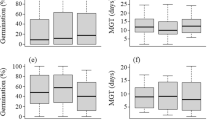Summary
Needles from spruces at different environmental and physiological conditions were analyzed by long term delayed luminescence in the seconds-range (LDL) using a novel set-up with on-line computer and a specially written computer program. Upon red light induction, the LDL-kinetics showed a super-position of three exponentially decaying components (“fast”, “medium” and “slow”) with reaction constants ofk f =5−15 s−1,k m =0.8−1.8 s−1 andk s =0.13−0.23 s−1,k s -values are fairly independent of the individual tree and quite stable throughout the whole year. They are also independent of the status and localization, i.e. the physiological situation of the individual tree. However,k m -andk f -values as well as the related amplitudesA m andA f exhibit a general, significant seasonal variation and obviously are correlated with the damage class or the environmental situation of the individual tree. Therefore, the measurement of long term delayed luminescence might offer a valuable piece of information in search of an early detection of forest decline.
Similar content being viewed by others
Abbreviations
- SDL:
-
short term delayed luminescence (lasting from ms to µs), LDL long term delayed luminescence (lasting from s to min)
- OTC:
-
Open Top Chamber
References
Burger J, Schmidt W (1988) Effect of depletion and supplementation of various chemical components on long term delayed luminescence ofScenedesmus obliquus. Plant Soil 109:79–83
Haug A, Jaquet DD, Beall HC (1972) Light emission from theScenedesmus obliquus wild type, mutant 8, and mutant 11 starins, measures under steady-state conditions between 4 ns and 10 s. Biochim Biophys Acta 283:92–99
Holzapfel C, Haug A (1974) Time course of microsecond-delayed light emission fromScenedesmus obliquus. Biochim Biophys Acta 333:52–58
Jursinic PA (1986) Delayed fluorescence: current concepts and status, in light emission by plants and bacteria. Govindjee et al. (eds) Academic Press, Orlando San Diego New York, pp 291–328
Krause H, Helml M, Gerhardt V, Gebhardt W (1982) In vivo measurements of photosynthetically active pigment systems in fresh water using delayed luminescence. Arch Hydrobiol Beih Ergebn Limnol 16:47–54
Krause H, Gerhardt V (1984) Application of delayed fluorescence of phytoplankton in limnology and oceanography. J Luminesc 31 & 32:888–891
Lavorel J (1975) Luminescence, in bioenergetics of photosynthesis. Govindjee (ed) Academic Press, Orlando San Diego New York, pp 223–317
Lichtenthaler HK, Buschmann C, Rinderle U, Schmuck G (1986) Application of chlorophyll fluorescence in ecophysiology. Radiat Environ Biophys 25:297–308
Malkin S (1977) Delayed luminescence. In: Barber J (ed) Primary processes of photosynthesis. Elsevier/North-Holland Biomedical Press, Amsterdam
Rutherford AW, Inoue Y (1984) Oscillation of delayed luminescence from PS II: recombination of (S2QB-) and (S3QB-). FEBS Lett 165:163–170
Schmidt W, Senger H (1987a) Long-term delayed luminescence inScenedesmus obliquus. I. Spectral and kinetic properties. Biochim Biophys Acta 890:15–22
Schmidt W, Senger H (1987b) Long-term delayed luminescence inScenedesmus obliquus. II. Influence of exogeneous factors. Biochim Biophys Acta 891:22–27
Schneckenburger H, Schmidt W (1991) Time-resolving luminescence techniques for early detection of forest decline. II. Picosecond chlorophyll fluorescence. Radiat Environ Biophys 31:73–81
Seufert G, Arndt U (1985) Open-Top Kammern als Teil eines Konzepts zur ökosystemaren Untersuchung der neuartigen Waldschäden. Allg Forstzeitschr 40:13–20
Stegmann HB, Schuler P, Rüff H-J (1989) Investigation of damage to forest by EPR spectroscopy in vivo. Photochem Photobiol 50:209–211
Strehler BL, Arnold W (1951) Light production by green plants. J Gen Physiol 34:809–820
Author information
Authors and Affiliations
Rights and permissions
About this article
Cite this article
Schmidt, W., Schneckenburger, H. Time-resolving luminescence techniques for possible detection of forest decline. Radiat Environ Biophys 31, 63–72 (1992). https://doi.org/10.1007/BF01211513
Received:
Accepted:
Issue Date:
DOI: https://doi.org/10.1007/BF01211513




